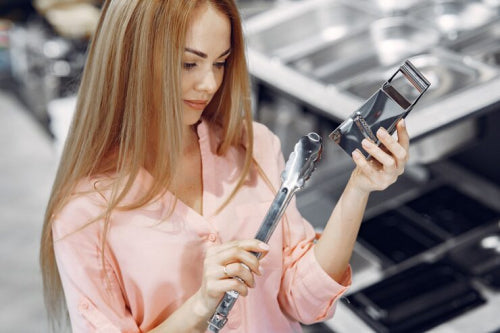You're standing in a bathroom showroom, surrounded by a dazzling array of faucets, showerheads, and towel bars, each one vying to be the centerpiece of your next renovation. The decision feels deceptively simple until you're caught between the warm, golden allure of brass and the crisp, mirror-like sheen of chrome. This isn't just about picking a finish; it's about crafting a space that balances style, durability, and practicality for years to come. In an era where bathroom fittings double as functional necessities and design statements, choosing the right material is a high-stakes decision. Let's explore the timeless appeal of brass versus chrome, weighing their strengths and quirks to help you make an informed choice for your bathroom.
Struggling with leaky, outdated bathroom fittings that spike bills and disrupt your day? Zap Bath Fittings offers 800+ premium brass and chrome fixtures, combining elegant design with lasting durability. Trusted for 20 years, our collections elevate kitchens and bathrooms with style and reliability. Transform your space with confidence. Shop Now!
Why Your Material Choice Defines Your Bathroom
Bathroom fittings are more than utilitarian components they're the subtle details that elevate a space from mundane to magnificent. A faucet's finish can transform a sink into a focal point or tie together a room's aesthetic. Beyond looks, the material you choose dictates durability, maintenance demands, and even how it feels to the touch. With the global bathroom fittings market valued at $60.33 billion in 2024 and projected to reach $101.38 billion by 2033, growing at a 5.64% compound annual rate, it's clear that consumers are investing heavily in these choices. Rapid urbanization, rising disposable incomes, and a growing appetite for stylish, energy-efficient solutions particularly in the Asia Pacific, which holds over 37.2% of the market are fueling this surge. So, how do brass and chrome stack up in this dynamic industry?
The Evolution of Bathroom Design
Gone are the days of basic fixtures and uninspired tiles. Today's bathrooms draw inspiration from luxury spas and boutique hotels, blending form with cutting-edge function. Consumers are increasingly prioritizing corrosion resistance, water efficiency, and sustainable materials, driving demand for innovative finishes. Advances in manufacturing, such as eco-friendly plating and durable coatings, are reshaping the market. Meanwhile, trends like matte finishes and mixed-metal designs are gaining momentum, reflecting a shift toward personalized, high-performance fittings. Against this backdrop, brass and chrome remain top contenders, each offering a distinct personality for modern bathrooms.
Interior designers note that some finishes are falling out of favor. According to industry insights, mass-produced, overly polished looks are losing ground to authentic, tactile materials that feel bespoke. This shift underscores the appeal of brass and chrome, which offer both timeless and contemporary options for discerning homeowners.
Brass: The Enduring Classic
Brass fittings exude a warm, golden glow that feels both luxurious and timeless. Crafted from a copper-zinc alloy, brass is naturally resistant to corrosion and boasts antimicrobial properties, making it ideal for the humid, high-traffic environment of a bathroom. Its aesthetic versatility shines in traditional and transitional designs, where its rich tones add depth and character. Unlacquered brass, in particular, is a darling of heritage-style renovations, developing a natural patina over time that tells a story of use and age.
Durability is brass's calling card. It thrives in moist conditions, promising decades of reliable performance when properly maintained. However, that maintenance can be a sticking point. Brass can tarnish, especially in hard-water areas, requiring regular cleaning with gentle, non-abrasive solutions to preserve its luster. Its higher upfront cost may also give pause, but for those seeking a long-term investment, brass delivers unmatched elegance and resilience. Think of a grand, historic home where brass faucets age gracefully alongside marble countertops a perfect marriage of form and function.
Chrome: The Modern Standard
If brass is the warm hug of tradition, chrome is the sleek handshake of modernity. Typically applied as a glossy electroplated finish over a steel or brass base, chrome offers a bright, reflective surface that's synonymous with contemporary design. Its mirror-like quality amplifies light, making it a favorite for minimalist urban bathrooms or compact spaces that need a visual lift. Chrome's affordability is another draw, making it a go-to for both residential renovations and large-scale commercial projects like hotels, where consistent shine and easy replacement are key.
But chrome isn't flawless. Its glossy surface is a magnet for water spots, fingerprints, and limescale, demanding frequent cleaning to maintain its pristine look. Over time, the plating can wear or scratch, particularly in high-use settings. Still, chrome's corrosion resistance and budget-friendly price point make it a practical choice for those prioritizing accessibility and low-maintenance elegance. Picture a sleek city apartment with chrome mixer taps glinting under recessed lighting a study in modern simplicity.
Real-World Applications: Where Each Shines
Consider a high-end residential renovation: the homeowner chooses unlacquered brass faucets for a powder room, embracing their evolving patina as a nod to timeless luxury. In contrast, a boutique hotel chain opts for chrome fittings across its bathrooms, valuing their uniform gleam and cost-effective upkeep for dozens of rooms. Some designers take a hybrid approach, blending brass towel bars with chrome showerheads for an eclectic, layered aesthetic that bridges classic and contemporary.
These examples highlight the versatility of both materials. Brass excels in spaces where character and durability are paramount, while chrome thrives in high-traffic or budget-conscious settings. The choice often depends on the mood you're aiming for cozy sophistication or crisp minimalism and the practical demands of your space.
Weighing the Challenges
Every material has its trade-offs. Brass's premium price can strain budgets, especially for larger projects, and its patina may not suit those craving a perpetually polished look. Chrome, while cost-effective, shows every smudge and scratch, making it less forgiving in homes with hard water or heavy use. Supply chain dynamics also play a role: brass fittings often face longer lead times due to specialized production, while chrome's widespread availability ensures quicker delivery. Sustainability is another consideration brass benefits from recyclable options, and chrome is improving with low-impact plating processes, but both require careful sourcing to minimize environmental impact.
Opportunities for Impact and Innovation
For businesses, the brass-versus-chrome debate offers strategic opportunities. High-end properties can market brass fittings as a premium, enduring choice, appealing to buyers who value craftsmanship and longevity. Chrome, meanwhile, provides an affordable, quick-install solution for developers or homeowners watching their bottom line. The industry's push toward sustainability opens further possibilities recycled brass or eco-conscious plating can attract environmentally conscious clients, aligning with the market's growth trajectory toward $101.38 billion by 2033. Companies that cater to these diverse needs can differentiate themselves in a competitive landscape.
Specialized reports, like those on brushed brass faucets, highlight the demand for tailored insights into specific finishes, helping professionals make informed decisions for niche markets.
The Future of Bathroom Fittings
Industry experts predict a vibrant future for bathroom fittings. Mixed-metal designs, blending brass's warmth with chrome's sleekness, are gaining traction for their bold, personalized appeal. Matte finishes and advanced protective coatings are also on the rise, offering durability without sacrificing style. Technologies like 3D visualization are transforming the shopping experience, allowing customers to preview finishes in their space before buying. Professionals recommend aligning your choice with your lifestyle: brass for those who cherish character and don't mind occasional upkeep, chrome for those seeking low-maintenance shine in a fast-paced world.
A Decision That Shapes Your Sanctuary
Choosing between brass and chrome is about more than aesthetics it's about crafting a bathroom that reflects your values and withstands the test of time. Brass offers enduring warmth and durability, a testament to craftsmanship that ages with grace. Chrome delivers modern polish and affordability, ideal for sleek, high-use spaces. As the bathroom fittings market surges, driven by urbanization and a quest for sustainable luxury, your decision carries weight. Consult a fittings specialist to ensure your choice aligns with your vision, budget, and lifestyle. In a space as intimate as your bathroom, the right material doesn't just complete the design it defines it.
Frequently Asked Questions
What are the main differences between brass and chrome bathroom fittings?
Brass fittings offer a warm, golden appearance with natural antimicrobial properties and excellent corrosion resistance, making them ideal for traditional and transitional bathroom designs. Chrome fittings provide a sleek, mirror-like finish that's more affordable and complements modern, minimalist spaces. While brass requires more maintenance and costs more upfront, it develops character over time, whereas chrome shows water spots and fingerprints more easily but offers budget-friendly elegance.
Which bathroom fitting material is more durable - brass or chrome?
Brass is generally more durable than chrome, especially in humid bathroom environments. Made from a copper-zinc alloy, brass naturally resists corrosion and can last decades with proper maintenance. Chrome, while corrosion-resistant, is an electroplated finish that can wear, scratch, or chip over time, particularly in high-use settings. However, both materials offer good longevity when properly cared for, with brass excelling in moisture resistance and chrome providing reliable performance at a lower cost.
How do I choose between brass and chrome faucets for my bathroom renovation?
Choose brass faucets if you prefer a warm, luxurious aesthetic, don't mind regular maintenance, and want a long-term investment that develops character over time. Opt for chrome faucets if you're working with a tighter budget, prefer low-maintenance fixtures, or want a sleek, modern look that amplifies light in smaller spaces. Consider your bathroom's design style, maintenance preferences, and budget - brass works best for traditional or transitional designs, while chrome suits contemporary and minimalist bathrooms.
Disclaimer: The above helpful resources content contains personal opinions and experiences. The information provided is for general knowledge and does not constitute professional advice.
You may also be interested in: Bathware Industry News Zap Bath Fittings
Struggling with leaky, outdated bathroom fittings that spike bills and disrupt your day? Zap Bath Fittings offers 800+ premium brass and chrome fixtures, combining elegant design with lasting durability. Trusted for 20 years, our collections elevate kitchens and bathrooms with style and reliability. Transform your space with confidence. Shop Now!
Powered by flareAI.co

